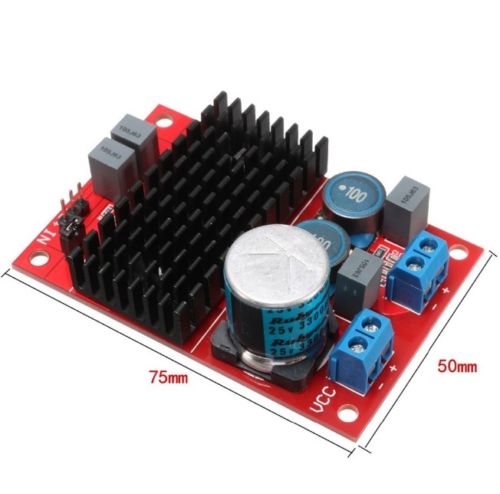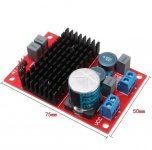I see cuts in groundplane topside too befor inductors, so chip and decoupling entirely on source ground, outputfilter and big electrolytic have powersupply ground ? No connection at all?
Adding a little 2nd harmonic could be nice. Are the thd plots with sanwu (clone?) or with the bigger boards already?
The sanwu here has 6 times (or more) higher poweroutput than groupbuy (mono, 3 different versions) 3116/18 boards or any chinese version I tried, on hybrid electrostatic loudspeakers with very low dipping/dropping impedance. Difference is very far from small, chinese audiobah/ac for example trips protection at 1/16th of sanwu poweroutput. I never tried YJbb, that already seems to struggle with 4 ohm speaker.
Adding a little 2nd harmonic could be nice. Are the thd plots with sanwu (clone?) or with the bigger boards already?
The sanwu here has 6 times (or more) higher poweroutput than groupbuy (mono, 3 different versions) 3116/18 boards or any chinese version I tried, on hybrid electrostatic loudspeakers with very low dipping/dropping impedance. Difference is very far from small, chinese audiobah/ac for example trips protection at 1/16th of sanwu poweroutput. I never tried YJbb, that already seems to struggle with 4 ohm speaker.
i will put up some pics of new board after removing some components so better view.
the plots are with sanwu at 3.5 kHz wich is worst case according to data sheet.
Homemade balanced passive filter for thd analyzer.
my board has a star ground if not sure you asking.
the plots are with sanwu at 3.5 kHz wich is worst case according to data sheet.
Homemade balanced passive filter for thd analyzer.
my board has a star ground if not sure you asking.
My background is high reliabilty mil/automotive and extreme environment oil-gas. Screw terminal connections are not allowed.
I prefer soldered anyway for this class-d app, guaranteed low z power connect.
-
Not correct: military equipment often uses screw terminal blocks; there are several MIL-STD concerning these components.
My background is high reliabilty mil/automotive and extreme environment oil-gas. Screw terminal connections are not allowed.
-
It would maybe (I have my doubts) be correct this way: Screw terminal connections are not allowed in high reliabilty mil/automotive and extreme environment oil-gas. Even if this would be 100% true, this is audio and soldering straight to boards does not seem the ideal approach in those environments as well....
I am practically sure soldering is not allowed in such environments as I have yet to encounter this phenomenon in my profession. In industrial environments often, if not almost always, crimped plugs are used AFAIK. Using those would give best of both worlds, also in audio. Point is the need for the right crimping tool. Soldering wires straight to boards is not common in any quality device. It was standard at least 30 years ago to do so. It gives the famous DIY feeling especially when needing to repair or modify stuff, certainly when PCB tracks peel off from mechanical stress or desoldering wires.
Audio is hardly an extreme environment (except for opinions 🙂 ).
Last edited:
The sanwu here has 6 times (or more) higher poweroutput than groupbuy (mono, 3 different versions) 3116/18 boards or any chinese version I tried, on hybrid electrostatic loudspeakers with very low dipping/dropping impedance. Difference is very far from small, chinese audiobah/ac for example trips protection at 1/16th of sanwu poweroutput. I never tried YJbb, that already seems to struggle with 4 ohm speaker.
Hi Irribeo, are you saying those small Sanwu boards are superior to other boards ? What is the reason ?
That's the point - proper crimping and tools. Bad crimping leads into problems sooner or later.
The best crimping pliers i know/use are "Engineer PA-09" and "PA20/21" from Japan.
The best crimping pliers i know/use are "Engineer PA-09" and "PA20/21" from Japan.
Quality connectors can be bought everywhere. Quality tools are hard to find if one does not want the Ebay stuff. I found the original Molex tools (used but in very good shape) for 20 Euro a piece. There is no excuse for bad crimping. When the right tools are used it is only the person crimping that can be blamed. If that is you yourself you know who to address to 😀 Still not a valid reason to justify soldering wires to boards. I went to school very long ago and even then it was already taught to be bad practice. Same with soldering and then cutting, mediocre mounting of boards etc.
Last edited:
Not correct: military equipment often uses screw terminal blocks; there are several MIL-STD concerning these components.
Only a full circle loop lug requiring removal of screw. ( no open spade)
That omits the blocks you were referencing.
The customers ultimately decide anyway.
many attempts have been made to use off-the-shelf commercial equipment Aka COTs) with side blocks etc. they have been specified when the permanent equipment was under design so only a temporary install but that is an exception
these installations were generally scrapped eventually do to reliability issues remember these environments are extreme. vibration , temperature cycling and shock physical abuse.
Those terminal blocks can work in an installation that is not mobile and permanent.
I never have problems with crimping.
I put the sock on, crimp it, and then apply solder to the joint. Voila.
I put the sock on, crimp it, and then apply solder to the joint. Voila.
I see cuts in groundplane topside too befor inductors, so chip and decoupling entirely on source ground, outputfilter and big electrolytic have powersupply ground ? No connection at all?
Adding a little 2nd harmonic could be nice. Are the thd plots with sanwu (clone?) or with the bigger boards already?
The sanwu here has 6 times (or more) higher poweroutput than groupbuy (mono, 3 different versions) 3116/18 boards or any chinese version I tried, on hybrid electrostatic loudspeakers with very low dipping/dropping impedance. Difference is very far from small, chinese audiobah/ac for example trips protection at 1/16th of sanwu poweroutput. I never tried YJbb, that already seems to struggle with 4 ohm speaker.
Here is link to info on dominant 2nd 3rd or mix of both. SS but works same on the 6sn7.
http://www.diyaudio.com/forums/solid-state/290026-simple-discrete-sziklai-pre.html#post4684522
Im driving two kef uniQ q10 in parallel from the $6 bd.
The uniQ are 6ohms so I have a 3ohm load.
The sound quality is astounding.
If somebody is testing at bench one PBTL 3116 board, I’m asking him to hook an oscilloscope probe between ground and one of the two outputs and watch the waveform (with a sine wave at the input).
Doing this with two different PBTL boards, I saw, for each of them, a very distorted waveform, despite the differential output voltage was clean (distortion is more evident at frequency higher than 10kHz); it seems like the harmonics generated by one of the half-bridges were cancelled by the harmonics produced by the other half-bridge.
I’ve never seen something like this in BTL 3116 boards.
Doing this with two different PBTL boards, I saw, for each of them, a very distorted waveform, despite the differential output voltage was clean (distortion is more evident at frequency higher than 10kHz); it seems like the harmonics generated by one of the half-bridges were cancelled by the harmonics produced by the other half-bridge.
I’ve never seen something like this in BTL 3116 boards.
Why ? You know what the best connection is don't you ? I have my doubts at the quality of those specific connectors blocks (probably ferro or famous chinese "any-metal mix") but Phoenix ones are better than soldering to pins. More flexible too and less problems with mechanical stress.
So quality screw terminals are better than a soldered connection? (Honest question.)
I always prefer screw terminals for the simple reason they are more convenient than busting out the soldering iron whenever I want to change something (which is fairly often given this particular hobby).
I find convenience and performance to be mutually exclusive more often than not.
As always, it depends. A quality screw terminal will also fail if used improperly. The advantage of a screw-terminal (or crimp/lock connection) is, that the whole connection process can be specified, like tightening force, crimping force etc.
A solder connection is always unique.
A solder connection is always unique.
i remember in school flowing solder into mechanical connects and seeing z bridge drop.
Since class-d is sensitive to supply z should we not make connections soldered if possible?
-
Since class-d is sensitive to supply z should we not make connections soldered if possible?
-
A single Q10 drops to ~3 ohm already 🙂 Treble impedance doesn't rise very much for most uniQ's I say, avoids peaking classD filter. Could be good choice for these amps.
Tuning bias for 2nd/3rd harmonic balance after 3116/18 is a nice option with your pre.
Tuning bias for 2nd/3rd harmonic balance after 3116/18 is a nice option with your pre.
After a while, I took a search on ebay and found some new tpa3116 mono boards I have never seen before. Any info about this board? which is $5 dollar, has nice heatsink and a huge capacitor.
DC 12V-24V TPA3116 Mono Channel Digital Power Audio Amplifier Board BTL Out CA | eBay

DC 12V-24V TPA3116 Mono Channel Digital Power Audio Amplifier Board BTL Out CA | eBay
Attachments
I got two just before Christmas, they are quite noisy out of the bubble wrap.
They have been mentioned here before btw, not sure if was this thread though.
They have been mentioned here before btw, not sure if was this thread though.
After a while, I took a search on ebay and found some new tpa3116 mono boards I have never seen before. Any info about this board? which is $5 dollar, has nice heatsink and a huge capacitor.
DC 12V-24V TPA3116 Mono Channel Digital Power Audio Amplifier Board BTL Out CA | eBay

I would say you get whag you pay for. It's not going to bz impressive.
I would say you get whag you pay for. It's not going to bz impressive.
Why do you say that? That's about the average price for any TPA3116 board, much of them pretty impressive?
Why do you say that? That's about the average price for any TPA3116 board, much of them pretty impressive?
I say that because I do, and because I know what electronics go into an amplifier. There's also no onboard, gain controls.
There's only a meh-quality input cap, too.
- Home
- Amplifiers
- Class D
- TPA3116D2 Amp
